THE TRANSFORMATIVE JOURNEY
An inclusive and holistic adult education
to develop transformative competences and reduce educational povertyUsing creative, informal, artistic languages,
learning is the result of global experience of body, mind, spirit,
individual, group and community.Social, economic, cultural and linguistic barriers are also transformed,
in favor of a human and universal uniqueness.
An introduction
Humans are physical, biological, psychological, cultural, social, historical beings. This complex unity of human nature has been so thoroughly disintegrated by education divided into disciplines, that we can no longer learn what human being means. This awareness should be restored so that every person, wherever he/she might be, can become aware of both their complex identity and shared identity with all other human beings. The human condition should be an essential subject of all education. (Edgar Morin, Seven complex lessons in education for the future, Unesco 1999)
Starting from this statement, we have choose a metaphorical and maieutic approach to adult eduction. Metaphors are bridges between inner individual meanings and collective archetypes and senses. They are both cognitive and embodied.
Read more...
Metaphors are not only as consciously and creatively used phrases, but as a powerful cognitive phenomenon where our every-day use of language both reflects and affects our thinking in ways that often remain subconscious.
Metaphors are selective in the sense that they can highlight particular aspects of the life experience and background others.
Attentiveness to the personal narrative, including the experiences and perceptions, is a central element of the educational process in a person-centered approach.
The use of metaphors is believed to be significant in the development of a common language which can enrich the relationship between the participant and the educator, as long as the learners’ own use of metaphors is allowed to guide the communication.
So, if one way to understand our lives is with metaphor, what is the metaphor we want to live? What story or poem do we want to write with our life? And we need to re-write the cultural story to include the “gap years,” time to “find yourself” or time to step off the train and ride a camel on the silk road. Time to restructure society instead of just fitting in.
There is a large variety of artistic methods and artistic ways of metaphorical representation. Examples include visual methods (e.g. photography, collages, murals, carving, quilting and painting), narrative methods (e.g. poetry, fiction, novel) and performative methods (e.g. film-making, theater, dance).
Transformation can be defined as “…. a significant reconfiguration of perception… for the emergence of new psychological perspectives that contribute to living a more creative life” (Gerber et al., 2012, p. 45).
In the proposed educational process, the dynamic interactive themes are: ruptures, resolutions and transformation; relationship and intersubjectivity; imaginational flow, sensory/kinesthetic/embodied ways of knowing, and intra/intersubjective transcendence.
Personalized learning can give each learner the opportunity to learn effectively and efficiently based on his or her own assets of skills, knowledge, and abilities, supporting a learner-centered education. It also can provide the opportunity for wide-scale access to quality learning and teaching where public or open education has fallen short due to limited resources.
Adult learners have various reasons, access, time, motivation, and resources for learning, which would affect the way a tailored or individualized experience would be designed for them.
Only the multiplicity of mind-body-spirit languages allows the educator and the learner to face such an intimate and personal transformative journey, within the safe space of the group, to bring the transformative effects to the community.
Start the journey
A journey is a common metaphor for life as it reminds us that the destination is not our only goal. Like with any form of a journey, there are times when the roads are straight and times when they are winding. There are ups and downs and potholes along the way.
In this phase of the educational journey, the participant reflects on what he/she has, what he/she needs to face the journey and what to pack.
Packing may sound simple, but it’s a rule-of-thumb science that travelers often learn the hard way along the way. Doing it strategically can make the difference between a rushed vacation with countless detours to local pharmacies and a lean one with everything you need close at hand. Here’s our shortcut to packing your bags the right way: how to find the best luggage, minimize the load, prepare what you need for a trip to the beach or business trip, and reduce the creases in your clothes.
When asked about one’s transformative experience, many would respond with travelling. It gives you the opportunity to get out of your comfort zone and explore different places, traditions, cultures and gain new and invaluable experiences!
TIPS FOR EDUCATORS
Before starting is time to go to the integrated competences self recognition work

TIPS FOR EDUCATORS
You can use this transformative competences cluster to design or reshape your educational path for personalized learning. Consider that not all competences must be considered in the same path, they are rather a compass during the journey and in defining and verifying learning outcomes. For each learning phase, it is possible to propose a practical, immersive, creative experience based on an expressive language: movement, music, singing, qigong, taiji quan, poetry, writing, dance, sound, theater, color, ...
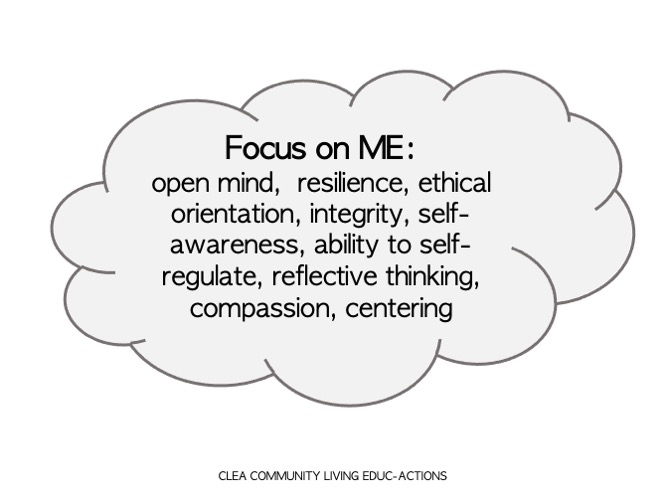
TIPS FOR EDUCATORS
You can use this transformative competences cluster to design or reshape your educational path for personalized learning. Consider that not all competences must be considered in the same path, they are rather a compass during the journey and in defining and verifying learning outcomes. For each learning phase, it is possible to propose a practical, immersive, creative experience based on an expressive language: movement, music, singing, qigong, taiji quan, poetry, writing, dance, sound, theater, color, ...
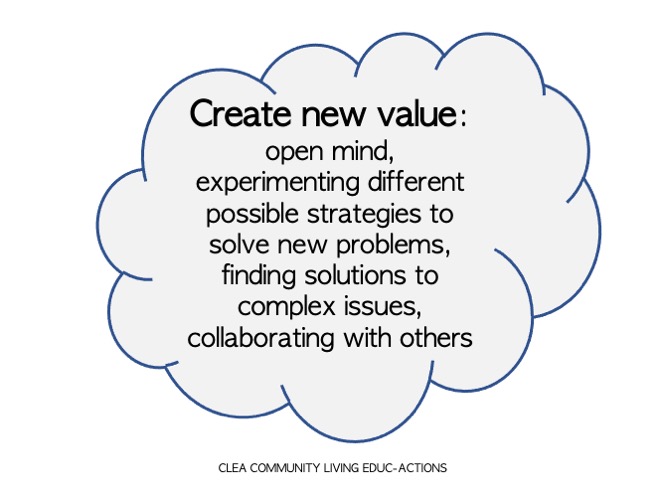
LEARNING OUTCOMES: a conscious, expanded ME, able to create new value
In transformative processes it is important to be able to visualize the map of the agents. Those who work in and with learning processes know well that the focus is often progressive and that the targeted behaviors can be numerous, articulated, complex.
Generally we start from the individual, understood as the uniqueness of the active subject, with its resources: we starts with the individual, because it is the most comfortable and natural elementary unit to start a learning process or intervention of “agency”.
As we become more experienced and confident, the focus visualizes the entire context and force field.
The travel companions – THE OTHERS of the CLEA Project, does not simply represent THE GROUP, a multitude of people: it represents the ability of the subject and of all the agents of the force field to put themselves in and be in relationship.
The interior and relational path to represent and treasure the attention and awareness of all those processes in which the skills do not remain with the individual but evolve by increasing the tangible and intangible resources of groups and territories.
TIPS FOR EDUCATORS
You can use this transformative competences cluster to design or reshape your educational path for personalized learning. Consider that not all competences must be considered in the same path, they are rather a compass during the journey and in defining and verifying learning outcomes. For each learning phase, it is possible to propose a practical, immersive, creative experience based on an expressive language: movement, music, singing, qigong, taiji quan, poetry, writing, dance, sound, theater, color, ...
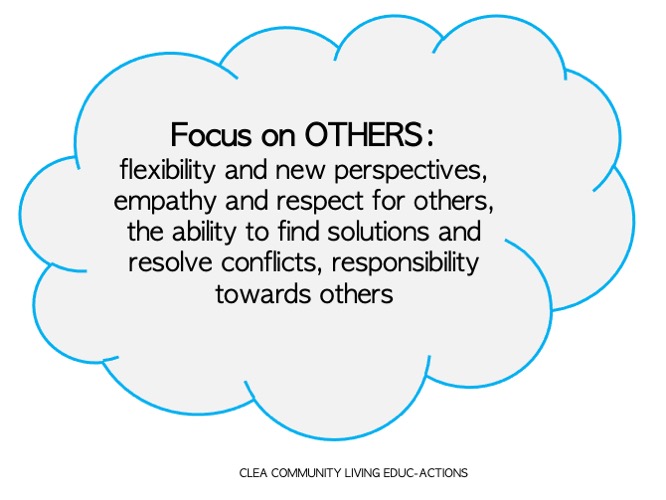
LEARNING OUTCOMES: MY agency is oriented to the others
The interpretative key offered by the psycho-sociologist Wilfred Bion always remains very topical on the transformative and evolutionary process of individuals and groups.
Bion distinguishes the alpha elements and the beta elements as a criterion for interpretative reading of the experience of appropriation that the body, mind, human spirit make effective towards emotions, feelings, thoughts (alpha), at the same time attributing an important potential role to all the elements left out and not considered (beta) in the functioning of individuals and groups, as well as to the value of the process of passing from beta elements to alpha elements, also thanks to the role of intersubjectivity (Bion W., Learning from Experience, Karnac Books , London 1984). Bion dedicates himself to the study of the functioning of groups in general and in particular dedicates himself to the therapeutic application field, attributing the transformative potential in an evolutionary sense to the intersubjectivity and group dynamics: transformative potential that he indicates as condition “O”, realizing synchronicity and unison.
The condition “O” also benefits from some particular attitudes and feelings such as “faith / trust and authenticity, then also a certain underlying happiness and an attitude of benevolence towards others and towards oneself”, (Neri C ., Il gruppo come cura, Raffaello Cortina Editore, Milano, 2021).
Really many ideas and suggestions to leave for a unique journey and to get a taste for unique and repeated journeys.
TIPS FOR EDUCATORS
You can use this transformative competences cluster to design or reshape your educational path for personalized learning. Consider that not all competences must be considered in the same path, they are rather a compass during the journey and in defining and verifying learning outcomes. For each learning phase, it is possible to propose a practical, immersive, creative experience based on an expressive language: movement, music, singing, qigong, taiji quan, poetry, writing, dance, sound, theater, color, ...
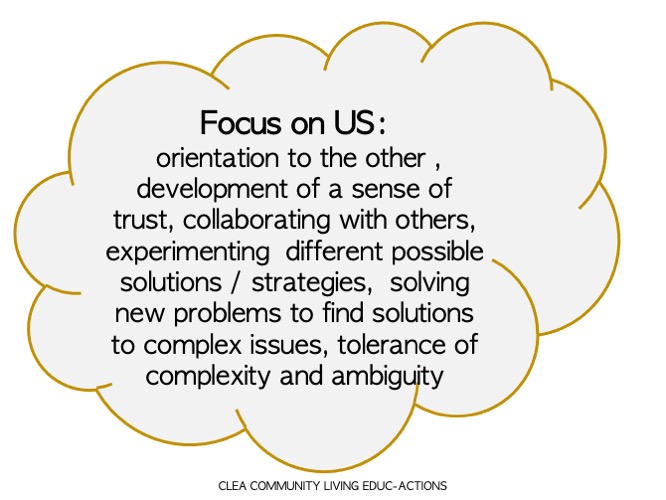
LEARNING OUTCOMES: WE capable of acting for a collective well-being
The much-despised routines, repetitions, sometimes identified with boredom and banality, have the quality of representing the anchors of human existence and therefore have a reassuring function in the human capacity to face reality.
But humans and groups, at the same time, identify humanity through the tension towards the new, in the creative functions, in the search for new solutions to old problems.
These functions of reflection and action, which respond on the basis of object (who, what), temporal (when), causal (why), topical (where), procedural (how), relational (with whom)principles, also include a component, global and pervasive, such as the “negative function”.
An open mind to discovery is a resource against fear – fear of failure, fear of mistakes, fear of appearing stupid – and instead live a life of commitment, authenticity and forward-looking action.
When change occurs, and it always does, we can consider it a negative aspect or an opportunity.
Instead of complaining we use change as an opportunity to explore new ideas and new solutions. Change is a propulsion mechanism. It is the raw material to generate innovation. Especially when change occurs, but even when it does not, the innovation process always opens up opportunities to always explore and benefit from new ideas, new solutions or new versions of what we do.
TIPS FOR EDUCATORS
You can use this transformative competences cluster to design or reshape your educational path for personalized learning. Consider that not all competences must be considered in the same path, they are rather a compass during the journey and in defining and verifying learning outcomes. For each learning phase, it is possible to propose a practical, immersive, creative experience based on an expressive language: movement, music, singing, qigong, taiji quan, poetry, writing, dance, sound, theater, color, ...

LEARNING OUTCOMES: able to deal with tensions and dilemmas
At the end of our journey, we discover that we are already immersed in a new path…is important to understand where and how we want go on, after having metabolized what the previous trip left us.
The intentions can guide us. An intention is like a seed that already contains the essence of what it will eventually become. As we plant the seed of intention and nurture it with our attention, we begin to notice all the people, events and situations that can guide us to experience greater happiness and well-being.Every journey should start by formulating an intention, and then let yourself be discovered.
Intention can be trained, perhaps by developing what Daniel Siegel calls “Mindsight” to describe our human capacity to perceive the mind of the self and others. It is a powerful lens through which we can understand our inner lives with more clarity, integrate the brain, and enhance our relationships with others. Mindsight is a kind of focused attention that allows us to see the internal workings of our own minds. It helps us get ourselves off of the autopilot of ingrained behaviors and habitual responses. It lets us “name and tame” the emotions we are experiencing, rather than being overwhelmed by them.
TIPS FOR EDUCATORS
You can use this transformative competences cluster to design or reshape your educational path for personalized learning. Consider that not all competences must be considered in the same path, they are rather a compass during the journey and in defining and verifying learning outcomes. For each learning phase, it is possible to propose a practical, immersive, creative experience based on an expressive language: movement, music, singing, qigong, taiji quan, poetry, writing, dance, sound, theater, color, ...
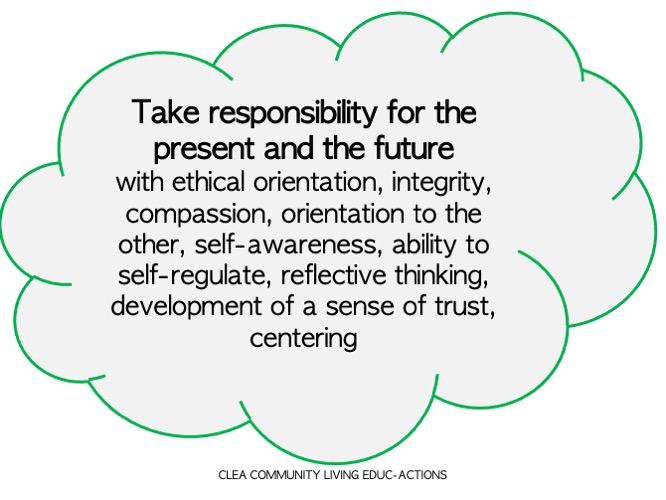
LEARNING OUTCOMES: able to face responsabilities for the present and future
TIPS FOR EDUCATORS
Is time to go to the integrated competences self recognition work


